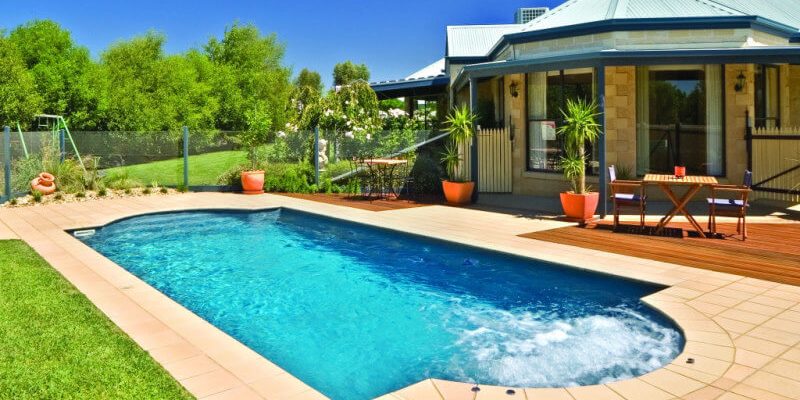A fibreglass swimming pool is not a simple curvy object, it is rather a one-piece structure that is completely made of fibreglass materials.
How fibreglass pools are manufactured
These fibreglass materials is approximately around three-eighths inches in thickness that means layers upon layers of fibreglass are attached to each other to form a strong fibreglass pool. A fibreglass pool has to be constructed from a mold in the factory. It is for this reason that fibreglass pools are not as easily customizable in terms of shape and size as concrete pools.
Once the fibreglass has been manufactured, there is a gel coat that is applied inside the finished product. This coat is what can be seen when one is swimming in a fibreglass pool. This coat starts off as a gel and then it hardens by polymerization which is a chemical bonding that strengthens it. This gel coat makes a fibreglass pool very smooth, algae resistant and quite durable and low in its maintenance needs. As a client, it is important to know whether the manufacturer you want to make your fibreglass pool has a warranty for the gel coat. This is because of osmotic blisters, which are issues related to water like leaking, may form on the gel coat causing structural problems.
The installation process
Getting a fibreglass pool is a two-stage process; after the manufacturing process, the installing process follows. Once the fibreglass pool is manufactured, the shell has to be transported to the pool site for it to be installed. This installation usually takes just a few weeks and the pool is ready for use. Before the pool is installed, the contractor does a quality check on the fibreglass. Any consistency or any cracks on the fibreglass are checked and fixed before the installation of the pool.
Cost of fibreglass pools
Most fibreglass pools cost between 45 and 75 thousand dollars. This estimated cost is the initial purchase. If there are any extra features or any upgrades, the cost tends to increase. The best part of this pool is that once it is installed, there is no need to purchase cleaning equipment and chemicals for the algae. The cost of maintaining this pool over a period of ten years is not as substantial as other pools. The low maintenance cost of this pool is what attracts most swimming pool buyers.
Pros of fibreglass pools
Installation time
An installation of a fibreglass pool typically takes from three to six weeks. This is one of the fastest installation time for a swimming pool in the market at the moment. Thanks to this speed, customers have less time invested in worrying about how their yards look. Installing this pool ensures that a customer does not need to manage construction workers at his backyard for months on end, thus lowering instances of stress.
Durability
This pool is strong enough because of its thickness. Therefore, instances of puncturing or scratching this pool due to everyday use is not an issue. The interior finish of the pool is user-friendly and it does not need to be refinished. This is true if the fibreglass swimming pool is correctly made.
Maintenance of a fibreglass pool
The gel coat used on the finishing of the fibreglass pool is non-porous. This means the surface of the pool does not require any form of weekly brushing like the concrete pool. Due to the non-porosity of the pool, algae will not form, meaning chemicals will not be needed. Also, the water chemistry will not be affected and the pH balance will remain constant.
General cost
The general cost of running or maintaining a fibreglass pool is quite minimal compared to other types of pool. These pools need fewer chemicals and electricity to run them, thus cutting down the cost of maintaining the pool.
Aesthetic value
Previously, when the fibreglass pools were introduced to the market, they looked rather simple and not as physically pleasing. With technology, fibreglass pools now have a variety of colored finishes, tanning ledges, water features, beautiful lighting, and versatile tiles. Fibreglass pools are no longer an eyesore but they have become architectural marvels in people’s backyards.
Disadvantages of fibreglass pools
Options
Fibreglass pools have a limit in terms of size. The reason for this is because fibreglass is created from molds that have been pre-designed in the factories. This also means that in terms of designs and shapes the options are very limited.
Cost
As much as this pool is not as expensive as a concrete pool, it is not the cheapest pool in the market. The initial cost of a fibreglass pool is usually less than one seventy five thousand dollars. This estimated cost is the initial purchase. If there are any extra features or any upgrades, the cost tends to increase. However, the vinyl liner pools are way cheaper.
As observed above, the advantages far outweigh the disadvantages of this type of swimming pool. Even though this swimming pool has design limitations, the available designs are nothing to look down upon. Fibreglass pools have been used for a long time. The durability, low maintenance, affordability and strength of this pool is a testament to its reliability. A Fiberglas swimming pool can be used in both spas and family homes.









